|
Monday, January 24, 2011
Progress Notes
In the Progress Notes of December 13, 2010 I discussed the Olean Telephone Switchboard and its first operator, William Bartsch (photo 01):
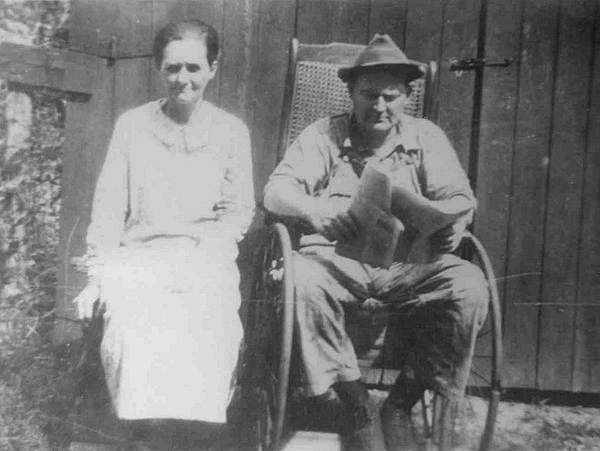
01 William and Lina Bartsch William’s granddaughter, Betty Roark, gave me additional information about the Bartsch family that I thought was of historical interest which I will discuss this week (photo 02).
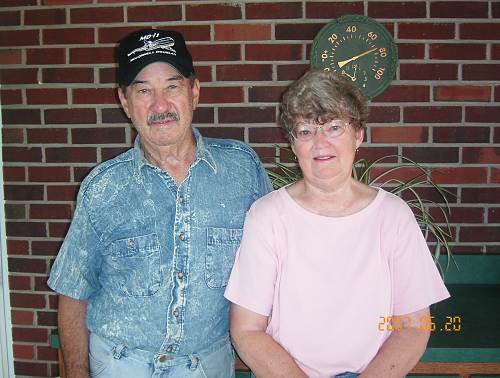
02 Bill and Betty Roark Betty’s great grandfather Joseph Ludwig Bartsch was born in Germany in 1850. He came to America when he was 19 with his brother Miller (photo 03).
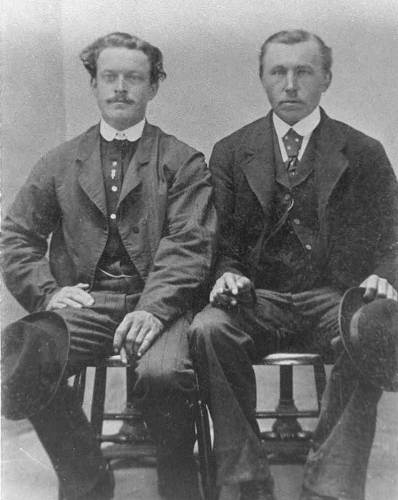
03 Joseph Ludwig Bartsch and brother Miller Betty has a photo of his parents (her great great grandparents) but does not know their names (photo 04).
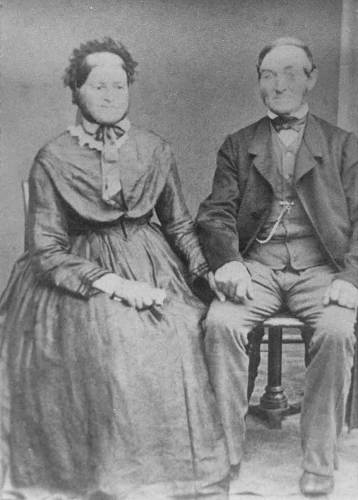
04 Parents of Joseph Bartsch Betty says her great grandmother Bartsch was born in 1855. Her name was Catherine Schlade Bartsch (changed to Slate in America) and she was a sister to Judge Slate of Cole County. She had Typhoid fever which caused her to have brain damage. That impairment may be the reason she accidentally swallowed some rat poison which caused her death in October 1891. She is buried in the Bill Amos Cemetery near Enon (photo 05).
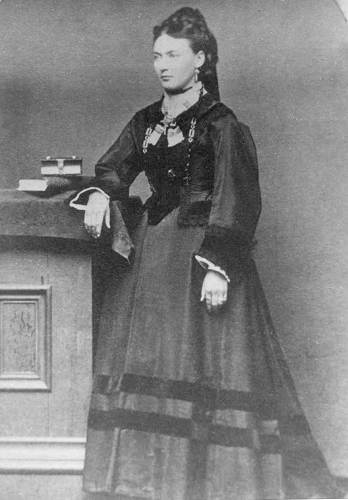
05 Great Grandmother Bartsch Catherine Slate Betty’s Great Aunt Tillie was a hat maker. Here are some photos we have of her (photos 06, 07 and 08).
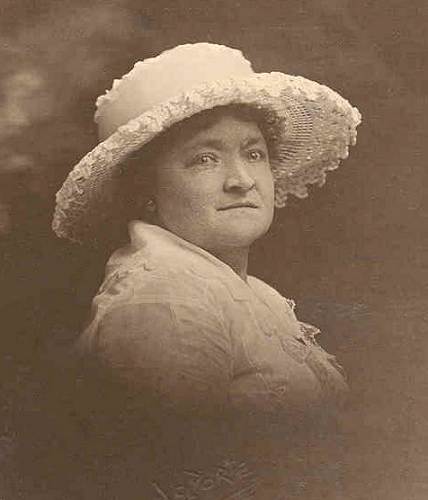
06 Great Aunt Tillie Bartsch
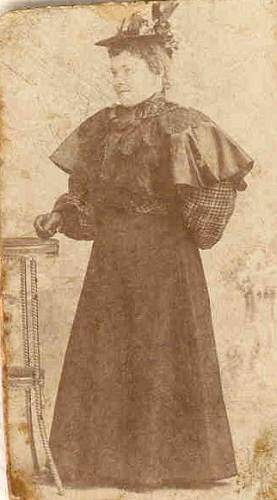
07 Great Aunt Tillie Bartsch
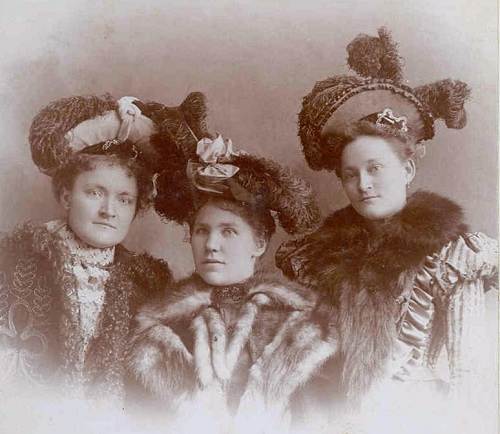
08 Tillie Bartsch, friend and Agnes The family brought with them a photo of an old church that was in great grandfather, Joseph’s album, which Betty thinks was the Bartsch family’s church in Prussia (photo 09).
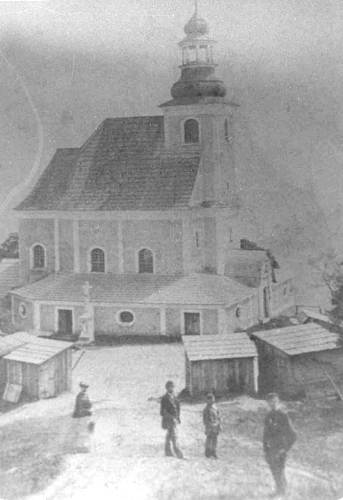
09 Bartsch Church in Prussia Betty has kept a clipping of a newspaper article in which she wrote about her memories of her grandfather William Bartsch which I will copy here.
(The clipping does not include the name of the paper or its date).
Memories of My Grandfather, Bill Bartsch
Betty Jean Harrison Roark (photo 10)
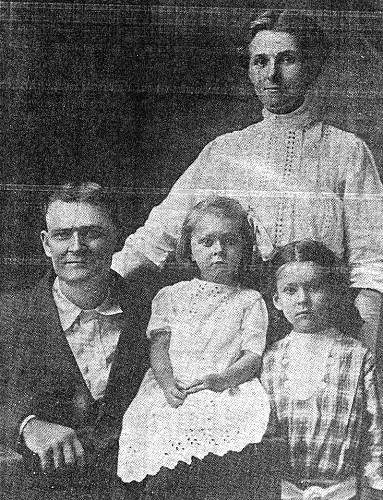
10 Bartsch Family - 1914 My grandfather, Bill Bartsch, died on January 6, 1949.
The earliest I can place any of my family in Olean is 1917, when grandpa and grandma, Bill and Lina Bartsch and their two little girls, Opal, 10 (my mom) and Edna, 8, moved there to take over operation of the Olean Switchboard (where the empty lot is across from Alleen Bishop).
Before that they had lived on a farm north of Olean where the Jerry Schupps now live.
When grandpa was 31, he fell from a wagon and injured his back. After seeing many doctors and being in much pain, a doctor from Eldon took him, by train, to the Mayo Clinic to see if they could help him. Can you imagine this trip in 1912? The doctors there determined his spinal column was ruptured and that he would never be able to use his legs again. From that time he was in a wheel chair, so the switchboard was the perfect job for him.
He had the personality for it! Anyone who knew him will remember how cheerful and helpful he was. The whole town and surrounding community knew him as “Uncle Bill.” Since he couldn’t do many chores, and couldn’t drive, he taught mom and ‘Aunt Edna how as soon as they were big enough.’ Many times mom would say “Dad showed me how to pain a wagon wheel,” or “how to plant a tree,” or “how to drive a Model T.” I think mom learned to drive very young!
When it started to get warm in April, he would say to Martha (my cousin) and me, “Kids, get a bucket and go down by the railroad bridge, the wild lettuce will be up.” And sure enough, it was. How he loved greens!
We never questioned him being in a wheel chair…that’s just the way it was. It was a big high backed wooden chair, nothing like the light metal ones they have now. When grandpa was in bed or gone with someone in the car, my brother, Billy Ray and I liked to play in the wheelchair. We’d go down the sidewalk around the house as fast as it would go, grab one wheel to turn the corner and try not to turn over.
Grandpa loved to hunt. If he could get Kemp Miller or some of the other boys to drive him they would drive the gravel roads in the evening when the rabbits came out. I remember one car he had, about a 35 Pontiac, with a hole in the windshield. Seems a coyote ran across the road in front of them and he got so excited he shot through the window.
I think that was the car that the hinges were at the back of the door instead of the front. It was easier for him to swing himself from the wheelchair to the car seat when the door opened that way. He was really strong in his arms. If you would hold the chair so it didn’t roll he could grab the top of the car and swing himself in.
He had a rope fastened to the ceiling above his bed. He would swing in and out of bed this way. Grandma wasn’t very big and she could never have taken care of him without this help.
I never questioned it at the time, but thinking back, I don’t know how they managed everything. We always had big gardens and canned everything we ate. I remember when it was time to make kraut, grandpa would put a kraut cutter across a washtub and cut head after head of cabbage and he always helped break beans and peel peaches. He taught me how to scrape a turnip with his pocket knife. They tasted so much better that way.
He chewed bees wax tobacco. It came in a big twist and I could buy two twists for a quarter at Haynes store for him. He also liked smoked herring that they kept in a barrel, three for a quarter, and coal oil (kerosene) was a quarter for a gallon for grandma’s four burner stove. She cooked on it when it was too hot to heat up the wood cook stove.
Running water, forget it! Grandpa even delighted in a fresh bucket of water, pulled up from the well in a long bucket with a rope and pulley. He would brag about how cold and good it was on a hot summer afternoon.
Lot of people dropped by to talk about the news. I remember how closely grandpa followed every move the Allies made during the war and how excited he was when the news came it was over.
Also, people dropped by to bring him things. I remember Uncle Pratt Amos bringing paw paws. They were like big green bananas and I have never seen one since.
Note: The farm in Tuscumbia my father owned when I was a boy had a paw paw tree. The paw paw fruit looked like the ones in this photo (photo 11).
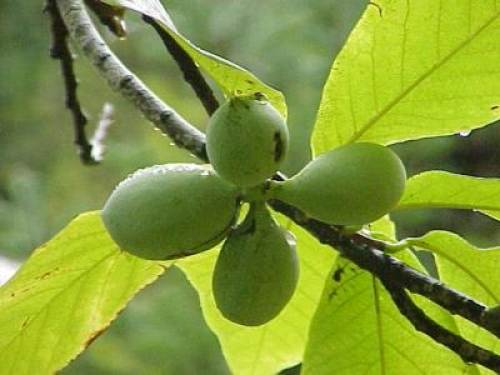
11 Paw-Paw I knew then the paw paw tree wasn’t very common in the area. Betty continues:
When the summer nights got hot grandpa would sleep outside. We didn’t have a fan and the houses really stayed hot. He was known for his loud snoring. Stan Currier said he always knew when grandpa was sleeping outside, because he could hear him a block away.
Few people knew the correct spelling of Bartsch, and most pronounced it “Barge.” Lots of their mail came that way.
The phone service in those days was very personal. Amy (Scrivner) Thompson told me when they lived near my folks, her son, Roger was small. He would ring the phone and when grandpa answered he’d say, “Bill Barge, Bill Barge, call my grandma.” Grandpa knew who was calling and who his grandma was and put the call through. People would let him know when they were going to be away for the day so when someone called for them he would say, “There’s no use calling them, they’re gone to Jefferson City,” or wherever. Many times I’ve heard him repeat a whole conversation when two people were trying to talk and couldn’t hear each other.
The favorite quote was “She said how was you all?” and the answer “tell her we’re all fine” no wonder we were all closer then (photo 12)!

12 Olean Switchboard He showed me how to look for animals in the big puffy clouds at sunset and told me thunder was the sound of “tater wagons rolling down the road. I still picture a big iron wheeled wooden wagon full of potatoes going by when I hear thunder (photo 13).
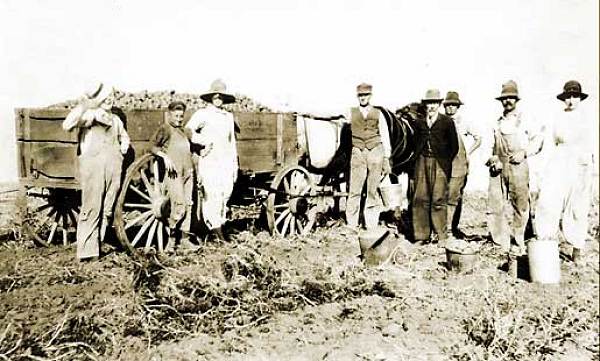
13 Potato Wagon Grandpa died January 1949 and was buried in the Olean Cemetery on my 15th birthday in a sleet storm. It was a very cold, sad day. I was very lucky to have such a great grandpa. I think he taught me to make the best of what you have and to be grateful for the small joys of life.
Thanks Betty for the additional information about your Bartsch family heritage.
In 1875 Midwest farmers and ranchers suffered one of the most destructive and unusual natural plagues historically ever to be recorded. It was due to an invasion of locusts which swarmed in numbers so large that the sky was obliterated as they invaded the fields and pastures destroying all forms of plant life. The species was known as the Rocky Mountain Locust, which soon disappeared but not until after inflicting so much devastation that nothing was left for the insects to eat and destroy.
Miller County was not spared from this disaster of nature. For example, this quote is taken from the history of the Miller County Kallenbach family written by Don Blankenship:
A story told by Valentine's (Kallenbach) son John Edward is that a severe drought affected central Missouri during the 1870's and caused tremendous hardship on the Kallenbach family (photos 15 and 16).
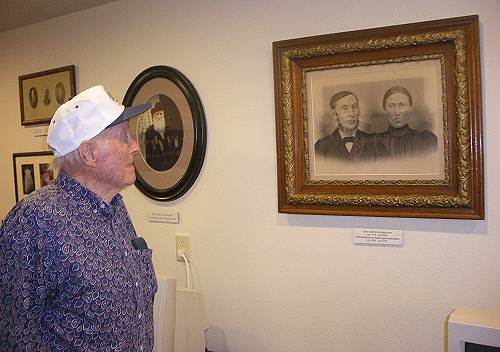
15 Royal Kallenbach looking at portrait of Grandparents Johann Valentine and Maria Kallenbach
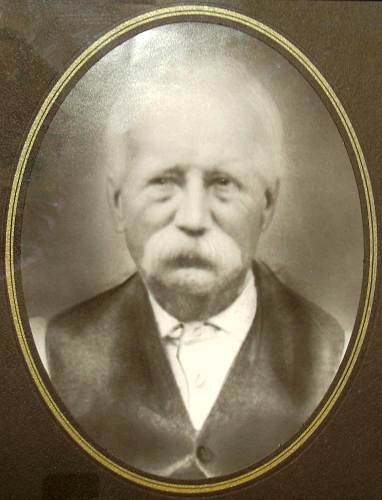
16 John Kallenbach Accompanying the drought was an infestation of grasshoppers or locusts. As a consequence the crops failed and the family's food supply during the following winter was seriously affected. The family had been entirely dependent upon what they raised for food. By the end of the following winter their food supply was entirely exhausted such that the only food they had to live on was corn bread, parched corn and sow belly from a semi-wild hog Valentine had managed to stalk and kill in the woods.
Another historical local reference to the plague occurred regarding a farm originally owned by an early Miller County physician, George Lansdown, which was located just across the line in Cole County. At the time of the plague the farm was owned by the Kerl family. This quote is taken from the previous Progress Notes of March 16, 2009:
Simon Kerl died in 1876, leaving his wife with a seven year old son, Thomas Theodore. Maria Sommerer Kerl married Simon's half-brother Markus Kerl soon after her first husband's death. But Kerl's management skills were inadequate to offset the drought, grasshoppers and unstable crop prices that plagued area farmers in the late 1870s, and by 1879 the family's debts had become overwhelming. When the farm was auctioned at the Cole County Courthouse, the successful bidder was Mathias Sommerer, Maria's father, who bought the farm for his two sons. Mathias Jr. received the western half and John Adam received the eastern half containing the Lansdown-Higgins House.
An early history of the great locust plague (locally known as the “grasshopper invasion”) can be found in the book, History of Missouri by Howard Louis Conard, published in 1899:
Grasshopper Year
History of Missouri
Howard Louis Conard
In the year 1875 the State of Missouri was subjected to a visitation of grasshoppers, or Rocky Mountain locusts. The insects, which had their habitat in the Rocky Mountains, had visited the State of Kansas for several years before, and caused some damage to the crops, but in 1874 they came in swarms, or rather in clouds, into Missouri, devouring such crops as were still in a green condition, and depositing their eggs for a more destructive campaign the following year. In the spring of 1875 they came forth in myriads and began to devour every green thing in some of the western counties. The foliage was stripped from the trees and the green blades from the corn, while the wheat, oats and grass were eaten off smooth to the ground, leaving the earth bare, and making the landscape oppressively dreary and desolate.
Farmers replanted their crops only to see them again devoured by the voracious insects, and the district invaded by them was threatened with famine. The ground was literally covered with them; they were crushed in offensive masses under the wheels of railroad trains, and they entered houses, covering the floors and clinging to the walls and filling drawers and cupboards in such number as to be a plague on the land. So serious was the visitation that Governor Hardin issued a proclamation setting apart June 3, 1875, as a day of fasting and prayer for deliverance, and there was a general observance of the day over the State, particularly in the “grasshopper district.” Shortly afterward the drought which had aggravated the calamity, was broken by abundant rains which washed away the insects in great quantities, and this was followed by an east wind which carried them in clouds from the State. In July the farmers replanted corn, and with the advantage of an unusually favoring season there was a good crop.
A recent book written by David Samuel Wilcove, No Way Home, gives a detailed analysis of the 1875 locust invasion. You can read the full account at Google Books.
However, I will copy here a condensed extracted excerpt of what Mr. Wilcove wrote about the great locust invasion of 1875:
No Way Home
(Copyright 2008)
David Samuel Wilcove
Locust Invasion p. 69
Other species of grasshoppers in North America are capable of achieving high densities on occasion, but none comes close to the Rocky Mountain locust. For settlers living in the Great Plains during the nineteenth century, locusts were an unpredictable menace. Years might pass with no sign of them, and then one hot summer day a cloud would appear in the sky, a strange, dark cloud unaccompanied by thunder or lightning. Within minutes, the fields would be covered in flying locusts…millions, even billions, of ravenous insects gnawing on any plan life they could find. The swarms might linger in a given area for a few days or weeks and then, just as quickly as they came, they would disappear, leaving behind devastated farms and frightened settlers.
Cloud unaccompanied by thunder or lightning. Within minutes, the fields would be covered in flying locusts…millions, even billions, of ravenous insects gnawing on any plan life they could find. The swarms might linger in a given area for a few days or weeks and then, just as quickly as they came, they would disappear, leaving behind devastated farms and frightened settlers.
The largest swarm on record swept through eastern Nebraska in June of 1875. Albert Child, a local physician with an intense interest in meteorology, took it upon himself to measure the swarm. By telegraphing people to the east and west of him, he determined that it consisted of a continuous front of locusts, over 110 miles long, moving northward. The wind was blowing at roughly 10 miles per hour, and the locusts were moving faster than that; he calculated their speed at 15 miles per hour. Multiplying that rate of travel by the number of days it took the swarm to move through southern Nebraska, he estimated a locust swarm roughly 1800 miles in length and 110 mils in width, or roughly 198,000 square miles. Such a swarm, as University of Wyoming entomologist Jeffrey Lockwood has noted, “would encompass the combined areas of Connecticut, Delaware, Maine, Maryland, Massachusetts, New Hampshire, New Jersey, New York, Pennsylvania, Rhode Island, and Vermont.”
The size of this swarm is so much greater than any other locust swarm ever recorded (the runner up being a 100 square mile swarm in Kenya in 1954) that one is forced to conclude that Child’s calculations were off the mark. But accounts from other settlers leave little doubt that whatever the size of the swarms, they were more than enough to constitute a nightmare for the men and women struggling to make ends meet in the harsh environment of the Great Plains in the late 1800s. A combination of a locust invasion followed by a harsh winter was enough to drive some communities to the brink of starvation. A report on the Rocky Mountain locust prepared by the U.S. Department of the Interior summarized the situation succinctly: “It has brought ruin and destitution to thousands of our Western farmers, and it constitutes today the greatest obstacle to the settlement of the country between Mississippi and the Rocky Mountains”
The farmers first tried chasing the locusts away from their fields, which proved as futile as fighting the dawn. They then realized that the insects were not only eating their crops but also were laying eggs in the soil. If the farmers could target the eggs or the hatchlings, they might be able to short circuit the invasion. This hope, in turn, led to the invention of strange devices like the Peteler Locust Crushing Machine and the King Suction Machine, which via rotating drums, rollers, wheels, and fans, attempted to crush, churn, or suck the hatchlings into oblivion.
Still other machines aimed to exterminate the pests by burning them out of the soil. Traps were devised as well (photo 20).
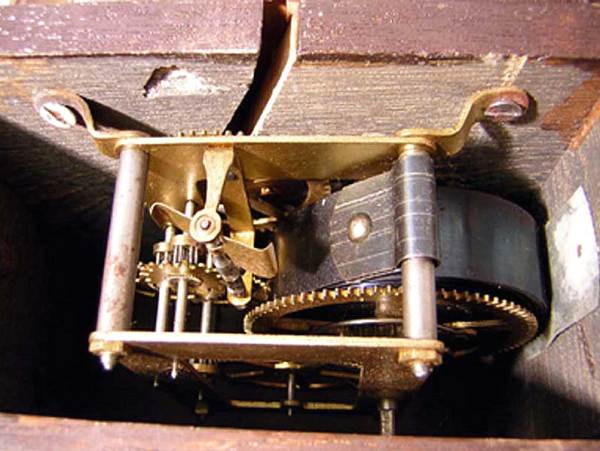
20 Locust Trap None was successful, except perhaps in lining the pockets of a few inventors and manufacturers. A somewhat more effective strategy was to flood the fields with water, which did in fact destroy the eggs. But water was and still is a scarce commodity in much of the Great Plains, making this an impractical option for most farmers.
Overwhelmed, the farmers turned to their county, state, and federal leaders for help, but in an era when relief was not seen as a responsibility of government, their pleas generated more debate and confusion than actual assistance. Eventually, the army was authorized to distribute clothing and food to some of the hardest hit areas, and some of the states agreed to provide limited cash payments and loans to destitute farmers. But neither the farmers nor their elected leaders knew hot to handle the periodic disasters caused y this one tenacious insect species.
And then the locusts disappeared. In the late 1880’s and 1890’s, a few scattered swarms appeared in Minnesota, Nebraska, and Iowa, but none thereafter. Because the swarms had always been unpredictable, neither the farmers nor the agricultural experts made much of the locusts’ disappearance at first. But as the years went by without a recurrence of the swarms, it became apparent that something had happened to the Rocky Mountain locust. On July 19, 1902, amateur naturalist Norman Criddle collected two Rocky Mountain locusts on his family’s estate in Manitoba, the last ones ever seen alive.
Over the years, a number of hypotheses have been offered to explain the disappearance of the Rocky Mountain locust. None is particularly satisfying, and some are downright silly…….
At this juncture Mr. Wilcove introduces a number of hypotheses to explain the disappearance of the Rocky Mountain Locust but he concludes that all the theories are flawed. And so we have no definitive explanation as to what caused the great locust plague of 1875 nor what ended it as well.
Finally, I finish this discussion of the Great Locust Plague of 1875 with a short essay about the references to Locusts in the Bible:
Laraine Rose
As a student of the Bible, I found it interesting that the locust is mentioned so many times therein.
Of the several Hebrew words rendered "locust," 'ar-beh' appears most frequently and is understood to refer to the migratory locust, the insect in its fully developed, winged stage. (Le 11:22,) The Hebrew word 'ye-leq' refers to the creeping, wingless locust, that is, one that is at an immature stage of development. (Ps 105:34 ; Joel 1:4) The Hebrew term 'sol-am' (edible locust) possibly refers to a leaper and not a flier. (Le 11:22) A locust swarm is denoted by the Hebrew term 'goh-vai'. (Am 7:1) The Greek word 'a-kris' is rendered 'insect locust' and 'locust.'-Mt 3:4; Re 9:7. The locust is equipped with two pairs of wings, four walking legs, and two much longer leaper legs with broad thighs. The wide, transparent back wings, when not in use, lie folded under the thick membranous front wings. By means of its leaper legs, the insect is able to jump many times the length of its body. (See Job 39:20.)
In Scripture the locust is at times used to represent innumerableness.-Jg 6:5; 7:12; Jer 46:23; Na 3:15, 17.
A CLEAN FOOD
The Law designated locusts as clean for food. (Le 11:21, 22) John the Baptizer, in fact, subsisted on insect locusts and honey. (Mt 3:4)
Today locusts are eaten by some Arabs. After having the head, legs, and wings removed, the locusts are dropped into meal and fried in oil or butter. These insects are said to taste something like shrimp or crab and are rich in protein; desert locusts, according to an analysis made at Jerusalem, consist of 75 percent protein. (It would take a lot of persuading before I would eat insects directly.)
LOCUST PLAGUES
In Bible times a locust plague was a severe calamity and, on occasion, an expression of God's judgment, as was the eighth plague on ancient Egypt. (Ex 10:4-6, 12-19; De 28:38; 1Ki 8:37; 2Ch 6:28; Ps 78:46; 105:34)
Locusts, brought by the wind, arrive suddenly, but the sound of their coming, compared in Scripture to that of chariots and of a fire consuming stubble (Joe 1:4), can, it is said, be heard at a distance of about 10 km (6 mi).The following Biblical description of a locust plague is no exaggeration: "As with the rumble of chariots they leap on the mountaintops; as with the crackling of a fiery flame devouring stubble; like a mighty people arrayed for battle. Before them peoples are in torment, every face blanches. They assault the city, they run upon the wall, they climb into the houses; in at the windows they come like thieves. Before them the earth trembles, the heavens shake; the sun and the moon are darkened, and the stars withhold their brightness." -Joel 2:5, 6, 9, 10, (New American Bible)
Their flight is largely dependent on the wind, which, when favorable, enables them to cover many kilometers. Locust swarms have even been seen by persons at sea more than 1,600 km (1,000 mi) from land. Unfavorable winds, though, can drive them into the water to their death. (Ex 10:13, 19)
An invasion of locusts can transform a land from a paradise like state into a wilderness, for their appetite is voracious. (Joel 2:3)
WITHOUT A LEADER THEY MARCH
A swarm of locusts progresses like a well-organized, disciplined fighting force, but without king or leader, this testifying to their instinctive wisdom. (Pr 30:24, 27)
Even though many perish, the onslaught continues. Fires built to check their advance are extinguished by the bodies of the dead locusts. Water-filled ditches are of no avail in impeding their progress, for these likewise become filled with their dead bodies and they march on. (Joel 2:7-9)
FIGURATIVE USE Research indicates that the life span of the locust is between four and six months. Appropriately, therefore, the symbolic locusts of Revelation 9:5 are said to torment men for five months, or what would commonly be their full life span.
When describing Assyria's military men, Nahum 3:16 mentions the locust's stripping off of its skin. The locust sheds its skin five times to reach adult size. It is reported that not until their bodies reach about 21° C. (70° F.) can locusts fly.
The first non indigenous people to arrive in Miller County were French and Spanish explorers followed soon afterward by trappers, mostly of French descent. This early history of our county was discussed by Gerard Schultz in his History of Miller County. His comments about these first arrivals to this area will serve as an introduction to an essay about the early trappers written more than a hundred years ago by Professor S. Waterhouse as included in the book, History of Missouri by Howard Lous Conard.
The Coming of the First White Men
Gerard Schultz (photo 22)
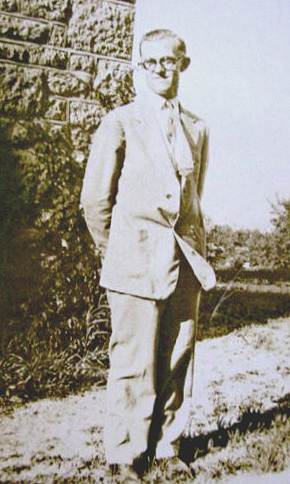
22 Gerard Schultz In
A History of Miller County
1933
Daring Frenchmen were the first white men to penetrate the Osage River region. As far as it is known, the first white man who traversed the territory now known as Miller County was Charles Claude DuTisne, a French explorer.
DuTisne in 1719 followed an overland trail of the Osage Indians, which led him to the headwaters of the Osage River. West of the present limits of Missouri, he took possession of the country in the name of the French king, and erected a column emblazoned with the arms of France.
Trade with the Indians was one of the most important motives for the advance of the first white men into the Osage valley. Under the French and Spanish regime the trade was farmed out to monopolies. During the last decade of the eighteenth century, Pierre Chouteau was granted exclusive right by the Spanish government to trade with the Osage Indians.
Chouteau’s trading post was located on the upper reaches of the Osage River where these Indians had their permanent villages. About the year 1800, this grant was given to Manuel Lisa.
It was estimated that the traffic with the Osages amounted to $28,000 annually at the time of the transfer of Louisiana to the United States. During the first decade of the nineteenth century two government trading houses, called factories, were established on the lower Missouri River. At these posts the Indians were to be supplied with goods at a more reasonable rate than that at which they had been accustomed to procure them. The field, however, was still open to private traders upon securing a license from the superintendent of Indian Affairs at St. Louis. Among those who secured licenses to trade with the Indians on the Osage was Jon B. Mathurin, who obtained his license on October 5, 1807. During the later summer and early fall of the same year, Joseph Dion and Baptiste Gouveville were granted licenses to hunt on the Osage River. The furs and peltries obtained by trading and trapping were principally those of the small deer, black bear, otter mink, muskrat, raccoon, fox, and also buffalo. These were transported down the Osage and Missouri Rivers to St. Louis.
The next essay is a very detailed description of the lifestyles and habits of the St. Louis fur trappers who came to Miller County and other areas outside St. Louis to trap or shoot fur bearing animals for the purpose of selling or trading the hides harvested. As I noted above, this narrative was written a long time ago which may give it some authenticity since the author, Professor Waterhouse, possibly could have met some of these early explorers and adventurers.
Hunters and Trappers
By Professor S. Waterhouse
IN
History of Missouri
Edited and written by Howard Louis Conard
More than three quarters of the male adults of early St. Louis were hunters. Some followed the chase the year round; others were engaged in it only a part of the time. The prospective profits of hunting founded, and the actual profits sustained, St. Louis. No class of it residents more actively contributed to the growth of the trading post than the hunters and trappers. Without the services of these hardy pioneers St. Louis could, at best, have attained only a tardy prosperity. It is quite probable that without their assistance the feeble life of the new born settlement would have been terminated by an early death. The hunters furnished the peltry which, in the beginning, was almost the sole commodity in which St. Louis dealt. They supplied the furs which the boatmen transported. To the services of these complementary factors the commercial prosperity of St. Louis owes its first impulses. Spending months at a time in the forests, sleeping in the open air, exposed day and night to every inclemency of the weather, living on the precarious supplies which the rifle provided, and subject to dangers, privations and hardships of every kind, the hunters and trappers became almost as hardy as the animals they pursued. By their tact and facility of adaptation they always preserved friendly relations with the Indians. They partially adopted the Indian style of dress and manner of living.
Many had Indian wives and sweethearts. Fair dealing and a careful avoidance of every just cause of offense won the confidence of the Indians. The genial good nature of the French and their easy conformity with the aboriginal customs were more than the fortunate accidents of a happy organization. They were qualities which were at that time of historic importance. Without the conciliation which such dispositions effected an extensive trade with the Indians would have been impossible. Amity and peace were the essential conditions of mercantile success.
An austere race, haughtily disregarding the traditions and tastes of the savages, would have provoked hostilities and prevented the possibility of commercial intercourse. The effect of national character upon public policy is conspicuously shown by the examples of France and England. The French were wont to conciliate their foreign subjects by personal kindness; the English were accustomed to hold theirs by the strong arm of military power. The two systems of treatment produced their natural effect upon the Indians. With a few exceptions, attributable chiefly to bribery and intrigue, the savages were friendly to the French and hostile to the English. The Indian trade, which French suavity won, fostered the growth of early St. Louis.
The garb of the hunters was picturesque. It combined the styles of civilized and savage life in proportions which varied according to the tastes and needs of the wearers. The description which tradition has transmitted depicts the various fashions which prevailed in different sections of the West. As it portrays the combined peculiarities of a vast region, its detail is not wholly applicable to any one locality. The garb here described is a representative type, rather than the exact dress of the St. Louis hunter. In the summer the hunter usually wore a light handkerchief on the head. It served as a protection against heat and insects. Adjusted in the style of a turban, and rich in gaiety of color, it formed an attractive head dress. In winter the head was covered with a fur cap or heavy woolen hood.
The hood was generally attached to the blanket cloak, which was used as an overcoat. In the warm season a light, loose shirt of coarse cotton, linen or linsey was worn. The trousers were commonly made of buckskin, but sometimes the material was domestic linsey or tow linen. They were cut so as to fit closely. Occasionally, instead of trousers, breeches and long deerskin legging were worn. In this case the thighs and hips were bare. A leather belt encircled the waist and buckled behind. The cloth which was folded around the loins was held in place by the girdle. The hanging ends were often gaily embroidered. A hunting shirt, with a large cape and loose sleeves, reached nearly to the knees. For winter use this frock was often made of dressed deerskin. The edge of the cape, the bottom of the skirt and the shoulder and wrist bands of the sleeves were adorned with colored tassels and fringes. The shirt opened in front like a coat, and was made so large as to lap at least a foot across the breast. The folds of the bosom served the purpose of a pocket. In this capacious receptacle were carried the food and other indispensable articles of a hunter’s outfit. The equipment always included slices of game, wads for the rifle, an awl and strips of buckskin for the repair of torn moccasins. In the neighborhood of settlements it was possible for the hunter to procure dried meat and cornbread, but the available supply was limited to the capacity of the folds of the frock. This food the hunter carried with him in the chase. When it was exhausted and when the fare which the rifle purveyed became distasteful, the wood ranger went for a fresh supply to an Indian village or returned to the stock which had been deposited in a temporary hovel, erected as a shelter from storms and a storehouse for provisions and peltries. But many hunters exclusively depended for subsistence upon the catering of their rifles. The moccasin was made of a single piece of heavy dressed buckskin.
A plain seam ran from the heel to the ankle, but the upper part, from the toes to the instep, was gathered. The shoe thread was the sinews of deer or strings cut out of buckskin. For winter service the top of the moccasin was made with long folds which wrapped around the ankle. In cold weather the shoes were lined with wool or deer hair. The hunter never set out on a trip without an ample supply of material for mending his moccasins. The flaps, or insteps, were sometimes embellished with beaded embroidery. In cold weather the hunter wore a hooded cloak made of heavy blanketing.
It was called a capote. The belt, which held the powder horn and shot bag, passed across from the left shoulder to the right side (photo 34).
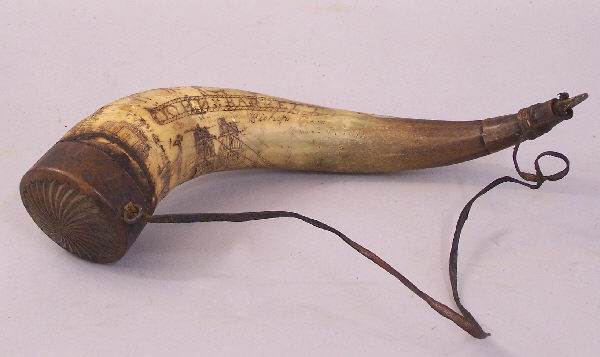
34 Powder Horn The hunter’s outfit was never complete without a hatchet and a strong knife. These were carried in leather cases attached to the girdle. Some rangers, when their hunting grounds were far from Indian villages, were accustomed to build a rude hut, in which they stored provisions and the skins of the animals which they captured. The frequency of their return to their headquarters depended upon their success with the rifle and the trap. They were occasionally absent for weeks at a time. If game was abundant the hut would be retained throughout the hunting season, otherwise another shelter was erected in wilds where the trophies of the chase were richer. The hunters were brave adventurers; no dangers or hardships daunted the spirit of these intrepid pioneers. Traversing the vast solitudes of the wilderness and penetrating the fastnesses of the Rocky Mountains, they were the first to make known to civilization the physical features of the far West. The enterprise of hunters anticipated the explorations of the government. Lewis and Clark were not the first to unlock the gates of the mountains. Indeed, the early expeditions which the government sent to explore the far West owed much of their success to the cooperation and practical guidance of huntsmen. James Pursley was a typical hunter. Animated with a spirit of daring adventure, he set out on a hunting excursion and, after roaming over the plains for three years, finally, in 1802, reached Santa Fe. To him has been ascribed the honor of being the first American that ever made this journey. In the service of the fur companies, or in the independent pursuit of game, the hunters traced the great Western rivers to their sources, traversed the basin between the Rocky and Sierra Nevada ranges, and ultimately crossed the continent. Their camping grounds were chosen with a keen appreciation of local advantages. The spots which their trained judgment selected often became the sites of prosperous villages. Their choice of a situation was of itself a strong presumptive evidence of its excellence. The valuable consignments of furs which they annually sent to St. Louis were the sources of its commercial success.
For the tact and just dealing with which they maintained friendly relations with the Indians, for the contributions which they made to physical knowledge, and for the services which they rendered in the extension of trade, the Western hunters deserve a tribute of historic praise. St. Louis, which owes so much to their adventurous hardihood, will ever cherish a spirit of gratitude toward the humble founders of its early prosperity.
That’s all for this week.
 Joe Pryor
Previous article links are in a dropdown menu at the top of all of the pages.
|

